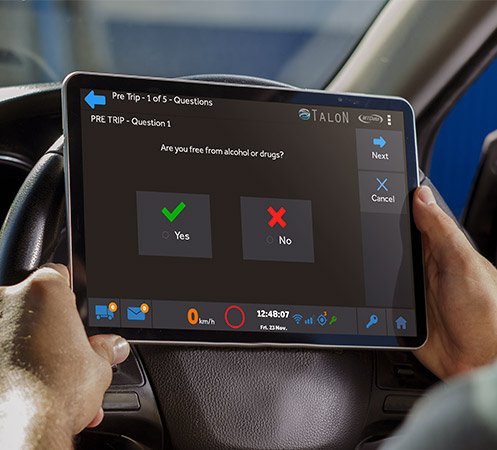Are monitoring devices good for the company?
Transport companies could benefit from devices to monitor the behaviour of drivers, and maybe benefit the drivers with evidence of their good behaviour.
So how? When might it be good, and what are the down sides?
What are telemetrics?
Telemetrics monitor the path of the driver – how long they have been driving, along which route, and with which speed, gears and brakes.
Used at its worst, telemetrics could be used as a stick that companies could hold over their drivers.
Used at its best, telemetrics can give great information as to the practicalities of driver management, and assist in their work.
Route awareness
Some devices ask a driver to plot their route into their navigation device.
This can prompt a driver to think about the route ahead, with the device warning of upcoming hazards, and suggesting alternative routes.
For example, a driver might be driving a truck that is taller than usual, and enter the course into the device. If the device knows how tall the truck is, and that there are height restrictions on the path entered, the device can then suggest a safer path long in advance of reaching it.
Devices can also bring up information about new routes that may warn of hills that need particular care in slowing down and slipping into a lower gear, or common weather issues in that area like fog or ice.
Monitoring fatigue
If a driver has been driving for 12 hours straight, then takes no more than a nap to drive another 10, then that is a recipe for disaster caused by driver fatigue.
Measures by the National Heavy Vehicle Regulator with log-book inspectors catch many overworked drivers per year and impose heavy fines before a fatal accident can happen.
Instead, compliance departments of transport companies can collect and review telemetric data, and fix such scheduling problems before those fines get imposed, and before fatal accidents happen.
That is, rather than waiting for a fine or a crash, we can use the data to regulate driver schedules for a safer company.
Speed
To impose a time schedule for the whole trip does not always allow for delays on the road, losing time which the driver may then attempt to make up for by speeding.
Having a monitor on board may back up the driver’s claim that there was a delay – a slow road due to roadworks or accident, for example – and avoid the driver having to explain why they were late. Rather than having a potential argument, the records can be shown.
Or perhaps the driver is a bit of a leadfoot, proud of completing a run ahead of schedule and signing off early. Again, a company’s compliance officer can review the data, reward the drivers who keep under the speed limit, and have a word with drivers who speed to see what the issue is before fines or accidents happen.
Outside of the driver being a leadfoot, there are other factors and accountabilities for speeding drivers. One primary factor is the trip or delivery plan set up for the driver. Has enough time been allocated to take into account traffic, roadworks, breakdowns etc. Is the plan created by a company, setting a driver up to fail due to speeding? If they have, then what is the comeback on the person who set the run up and the capmany they work for? In fact, the company may face as much scrutiny and prosecutions as the driver themselves. Food for thought on trip planning.
Rewards for good
I wrote elsewhere about the possibility of positive incentives for positive records. Imagine if a company were able to collect all of its data for all of its drivers, and each month of good driver compliance receive some kind of monetary bonus for doing so.
Usually this is an impossible dream, and have drivers and supervisors tempted to cook the books in pursuing those bonuses.
But automatic monitoring technology makes this possible. With continual monitoring and feedback, whole companies can be assured that their drivers are keeping safe.
I wouldn’t recommend that that data be piped directly to a government agency for potential rewards – we know that that would quickly be used for negative reinforcement.
Some device companies suggest that driver scorecards could be introduced. I might recommend against that too. Gamified scores induce competitiveness between individuals or departments, and that can create animosity within your company.
But a scheme may be developed in which companies who find that their records for the year were completely in the green may volunteer their records for rewards.
And I’m sure the insurance companies would be interested. They may come to the party on some reduced premiums.
In short, collecting driver data and putting it in the hands of your compliance department can be a great path to overall compliance, if the incentives are handled wisely.
Image Source : https://mtdata.com.au/solution/driver-safety-compliance/

